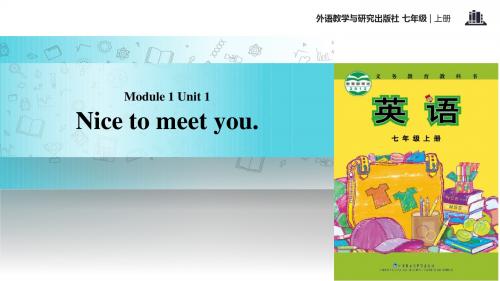(完整版)2017新外研版七年级上册单
- 格式:docx
- 大小:30.93 KB
- 文档页数:27






1 / 27 Starter Module1 hello [hə'ləʊ]你好,喂 class [klɑ:s]同学,班级 my [mai]我的 name [neim]名字 is [iz]是(动词be的第三人称单数现在 式) Miss [mis]小姐(对未婚女性的称呼), 老师 good[gʊd]好的 morning ['mɔ:niŋ]早晨,上午 good morning 早上好 afternoon [ɑ:ftə'nu:n]下午 good afternoon 下午好 goodbye[gʊd'bai]再见 I[ai]我 am [æm;əm]是(动词be的第三人称 单数现在式) I’m=I am 我是 Mr ['mistə(r)]先生 2 / 27
what[wɒt]什么 your [jɔ:; jə]你的,你们的 please[pli:z]请 sorry['sɒri]对不起,抱歉的 can[kæn, kən]能,能够 you[ju:]你,你们 spell [spel]拼写 it [it]它 yes[jes]是,是的 thank [θæŋk]xx how[haʊ]怎样,如何 are [ɑ:]是(动词be的复数和第二人称 单数现在式) fine [fain]很好的,不错的 thanks[θæŋks]xx Mrs['misiz]夫人,太太this [ðis]这,这个(指较近的人或事物)she [ʃi:]她 teacher['ti:tʃə]老师 friend [frend]朋友 her [hɜ:]她的 his[hiz]他的 nice[nais]美好的,令人愉快的to[tu:](与原形动词一起构成动词不定式) 3 / 27
meet [mi:t]遇见,结识 time[taim]时间 go[gəʊ]走,去 now [naʊ]现在,目前 bye [bai]再见 see[si:]看见 tomorrow[tə'mɒrəʊ]明天Module 2 sit [sit]坐 down[daʊn]向下地,向下sit down 坐下 open ['əʊpən](打)开 book[bʊk]书 listen['lisn]听,倾听 draw[drɔ:]绘画,画 put[pʊt]放,置 up [ʌp]向上地,朝上,向上hand[hænd]手 stand[stænd]站立 stand up 起立 close[kləʊs]合上,关闭new[nju:]新的 student['stju:d(ə)nt]学生here [hiə]这里,在这里in [in]在……里面 one[wʌn]一 two [tu:]二 4 / 27
[fɔ:] five[faiv]五 six [siks]六 seven ['sevən]七 eight [eit]八 nine [nain]九 ten [ten]十 telephone ['telifəʊn]电话 number['nʌmbə]号码 old[əʊld]……年龄的,…..岁的 how old 多大,几岁 twelve[twelv]十二 eleven [i'lev(ə)n]十一 thirteen[,θɜ:'ti:n]十三 fourteen [,fɔ:'ti:n]十四 fifteen[,fifti:n]十五 sixteen [,siks'ti:n]十六 seventeen [,sevən'ti:n]十七 eighteen[,ei'ti:n]十八 nineteen [,nain'ti:n]十九 twenty['twenti]二十 5 / 27
boy [bɔi]男孩 girl [gɜ:l]女孩 desk[desk]桌子 chair[tʃeə]椅子 bag[bæg]包,书包 Module 3 in [in]使用(使用某种语言) English['iŋgliʃ]英语,来自英格兰的 in English 用英语 a [ə; ei]一(个,件……) write [rait]写 on [ɒn]在…..xx the[ðə; ði:](指已经谈到或正在谈的事 物) blackboard['blæk,bɔ:d]黑板 OK[,əʊ'kei]行,好(用于表示同意,[pen] no [nəʊ]不,不是,没有(用于表示否定的回答) pencil['pens(ə)l; -sil]铅笔do [du:](用于构成疑问句和否定句)bird[bɜ:d]鸟 cat [kæt]猫 dog[ dɒg]狗 flower ['flaʊə]花 6 / 27
help [help]帮助 me [mi:](宾格)我 of [ɒv;əv]…..的 course [kɔ:s]当然 of course 是的,当然 classroom ['klɑ:sru:m]教室know[nəʊ]知道,懂得 say[sei]说,讲 that [ðæt]那,那个(指较远的人或事物) again [ə'gen;ə'gein]再(次),又(一次)welcome ['welkəm]受欢迎的,欢迎(迎接某人到某地的时的用语)You’re welcome 不用谢,别客气black[blæk]黑色的
white[wait]白色的 blue [blu:]蓝色的 green[gri:n]绿色的 yellow ['jeləʊ]黄色的 red [red]红色的 brown[braʊn]棕色的 orange ['ɒrin(d)ʒ]橘黄色的,柑橘,橙colour ['kʌlə]颜色 and [ænd]和,与 Module 4 day [dei]一天 7 / 27
today [tə'dei]今天 Monday ['mʌndei]星期一['tju:zdei; -di] Wednesday ['wenzdei; -di]星期三 Thursday['θɜ:zdei; -di]星期四 Friday ['fraidei; -di]星期五 Saturday['sætədei; -di]星期六 Sunday ['sʌndei; -di]星期天 birthday ['bɜ:θdei]生日 favourite ['feiv(ə)rit]最喜爱的 spring [spriŋ]春天 summer ['sʌmə]夏天 autumn ['ɔ:təm]秋天 winter['wintə]冬天 warm [wɔ:m]暖和的,温暖的 hot [hɒt]热的 cool[ku:l]凉快的 cold [kəʊld]冷的 weather['weðə]天气 like [laik]如同,像 London['lʌndən]xx basketball ['bɑ:skit,bɔ:l]篮球 8 / 27
football ['fʊtbɔ:l]足球 swimming['swimiŋ]游泳 table tennis['teibl ,tenis]乒乓球 sport[spɔ:t]运动 let[let]让,使 us[ʌs](宾格)我们 let’s =let us 让我们 play[plei]参加(体育运动或球赛),玩 耍 after ['ɑ:ftə]在…….后 school [sku:l]学校 idea [ai'diə]想法,主意 Module 1 Chinese [,tʃai'ni:z]n.中国人;汉语 adj.中国的;中国人的[frɒm; frəm] 自 where[weə]adv 在哪里,去哪里year[jɜ:, jiə]n.年龄;年about [ə'baʊt]prep关于What about 怎么样
Ms[miz]女士 America [ə'merikə]美国;美洲not[nɒt]不,不是,没有England['iŋglənd]英格兰hi[hai]嘿、喂 9 / 27
American [ə'merikən]n.美国人;美洲人adj.美国的;美国人的;美洲的 our[aʊə]pron.我们的 grade[greid]n.年级 he[hi:]pron.他 China['tʃainə]xx everyone['evriwʌn]pron.大家;每人capital ['kæpit(ə)l]n.首都;省会but [bʌt; bət]conj.但是,然而very ['veri]adv.很;非常
big [big]adj.大的 city['siti]n.xx small [smɔ:l]adj.小的 first [fɜ:st]adj.第一(位)的,首要的adv.先;首先first name 名字 last[lɑ:st] adj 最后的;最末的last name 姓 all [ɔ:l] pron 每个;全体Module 2 aunt [ɑ:nt, ænt]n.姨母;伯母;婶母;舅母;姑母 brother['brʌðə]n兄弟cousin ['kʌzən]n.堂兄弟;表兄弟;堂姐妹;表姐妹['fæmili; -m(ə)l-]
father ['fɑ:ðə]n.父亲爸爸 grandfather['g rænd,fɑ:ðə]n.(外)祖 父 grandmother ['g rænd,mʌðə]n.(外) xx